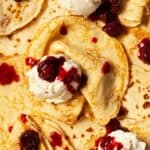English Pancakes - a recipe for thin pancakes
English pancakes are light, golden and traditionally served in the UK on Shrove Tuesday (Pancake Day.) Similar to French crêpes, this recipe for thin pancakes is simple to make and the pancakes can be served with a multitude of toppings – sweet or savoury.Makes approximately 8-10 pancakes depending on the size of the pan.
Servings: 10
Calories: 67kcal
Ingredients
- 125 g Plain flour all-purpose
- ⅛ teaspoon Salt
- 1 egg large, free range
- 250 ml Whole milk full-fat
Instructions
Make the Batter
- Begin by measuring the flour into a bowl or large wide jug. Add the salt and make a well in the centre. Crack the egg into the well and add ⅓ of the milk. Use a handheld whisk to break up the yolk and mix the milk and egg together briefly
- Keep beating and gradually incorporate the flour from the edges of the bowl
- When all of the flour is mixed in, add the rest of the milk, beating until just incorporated. It should have the consistency of single cream – if it is too thick add a little more milk
- Set aside to rest for at least 30 minutes (refrigerate if making in advance but allow to sit at room temperature for 1 hour before cooking)
Cook the Pancakes
- When ready to cook the pancakes give the batter a brief stir and heat an 8-inch (20cm) frying pan over a medium-hot heat for several minutes
- Test that the pan is hot enough to begin cooking by dropping a small knob of butter into the centre – it should immediately sizzle. If it does not then continue to heat the pan for a little longer. When ready to cook, tilt the pan to spread the butter out then pour in 3 tablespoon pancake batter and gently tilt and swirl the pan to allow the batter to spread out over the base of the pan
- Cook undisturbed for 1-2 minutes, then lift the edge of the pancake using a spatula or palette knife to check if it is sufficiently cooked. When it is golden brown underneath, give the pan a gentle shake to loosen the pancake then flip it over (using a fish slice or palette knife is fine) and cook the other side for a further minute
- Remove from the pan (serve or keep warm), add another knob of butter to the pan and cook the next pancake. Repeat until all batter is used up
Notes
Expert Cooking Tips
- Take care not to overmix the batter. Doing so will activate the gluten in the flour, leading to rubbery pancakes. Stop mixing when a few lumps of flour remain
- Remember to let you batter rest once it is mixed. During the rest period the gluten in the flour will relax and the milk will dissolve any remaining lumps. The milk will also release a little starch and protein in the flour. All of these actions result in superior pancakes that are light and tender
- Consider the size of your frying pan. If using an 8-inch (20cm) pan use 3 tablespoon batter (allowing 10 pancakes). A larger pan will require slightly more batter and will yield less pancakes accordingly. For a 10-inch pan use 4 tablespoon batter per pancake
- Once the batter is poured into the pan be quick in tilting and swirling the pan around to ensure the batter coats the entire base of the pan evenly
- Remember to add a fresh knob of butter to the pan in between cooking each pancake
- Some people find that the first pancake never cooks that well compared to subsequent pancakes. Consider pouring a small amount of batter into the pan as a test pancake. If it does not turn out perfectly, there is still plenty of batter left to make the rest and these will all turn out fine
- Have all of your toppings prepared before cooking begins (keep any hot items warm in a preheated oven)
Get the Pan Hot Enough
It's imperative to get the frying pan hot enough but not too hot. If the pan is not hot enough the pancakes will soak up the fat in there pan and end up greasy, but if the pan is too hot then the butter will burn and the batter won't spread far enough as it will cook too quickly. I generally find a medium-hot heat adequate. For example, if my hob heat went from a scale of 1 (low) to 9 (high) then I would go for around 6 - in other words, just ahead of the midway heat. Test that the pan is hot enough to begin cooking by dropping a small knob of butter into the centre - it should immediately sizzle. if the pan/ butter is smoking then it is too hot.How to Keep Cooked Pancakes Warm
If you intend to cook all of the pancakes up to serve all in one go then you will need to keep them warm once cooked. Before cooking begins, put a heatproof plate in a warmed oven (140C/275F/ GM1) and each time a pancake cooks transfer to the plate. Lay a sheet of greaseproof paper between each pancake to ensure they do not stick together and wrap the entire plate loosely in foil to prevent them drying out. Nutritional Information is calculated per pancake made using 3 tablespoon batterNutrition
Calories: 67kcal | Carbohydrates: 11g | Protein: 3g | Fat: 1g | Saturated Fat: 1g | Trans Fat: 1g | Cholesterol: 19mg | Sodium: 46mg | Potassium: 52mg | Fiber: 1g | Sugar: 1g | Vitamin A: 64IU | Calcium: 33mg | Iron: 1mg
